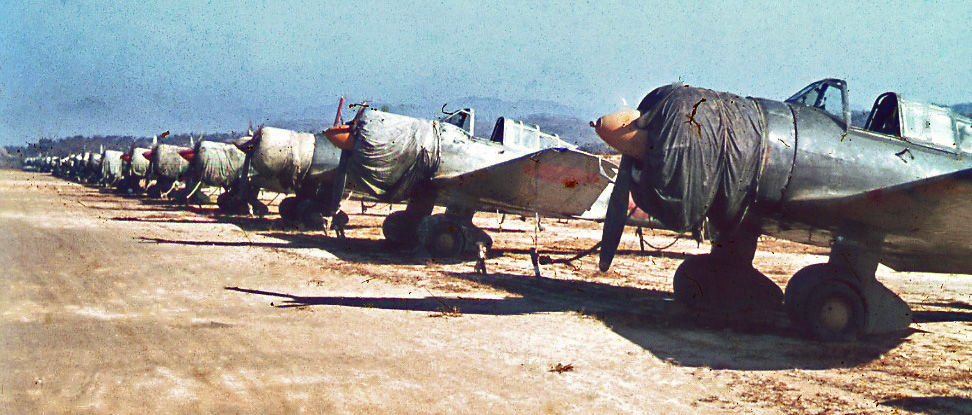Mitsubishi Ki-51 on:
[Wikipedia]
[Google]
[Amazon]
The Mitsubishi Ki-51 (Army designation "Type 99 Assault Plane"; Allied nickname "Sonia") was a "Charles Lindbergh and the 475th Fighter Group."
''Lightning Strikes''.



Mitsubishi Ki 51 Sonia at Warbirds Resource Group
{{Allied reporting names Ki-051 1930s Japanese attack aircraft Single-engined tractor aircraft Low-wing aircraft Ki-51, Mitsubishi Aircraft first flown in 1939
light bomber
A light bomber is a relatively small and fast type of military bomber aircraft that was primarily employed before the 1950s. Such aircraft would typically not carry more than one ton of ordnance.
The earliest light bombers were intended to dro ...
/dive bomber
A dive bomber is a bomber aircraft that dives directly at its targets in order to provide greater accuracy for the bomb it drops. Diving towards the target simplifies the bomb's trajectory and allows the pilot to keep visual contact througho ...
in service with the Imperial Japanese Army
The was the official ground-based armed force of the Empire of Japan from 1868 to 1945. It was controlled by the Imperial Japanese Army General Staff Office and the Ministry of the Army, both of which were nominally subordinate to the Emperor o ...
during World War II
World War II or the Second World War, often abbreviated as WWII or WW2, was a world war that lasted from 1939 to 1945. It involved the vast majority of the world's countries—including all of the great powers—forming two opposin ...
. It first flew in mid-1939. Initially deployed against Chinese forces, it proved to be too slow to hold up against the fighter aircraft
Fighter aircraft are fixed-wing military aircraft designed primarily for air-to-air combat. In military conflict, the role of fighter aircraft is to establish air superiority of the battlespace. Domination of the airspace above a battlefield ...
of the other Allied
An alliance is a relationship among people, groups, or states that have joined together for mutual benefit or to achieve some common purpose, whether or not explicit agreement has been worked out among them. Members of an alliance are called ...
powers. However, it performed a useful ground-attack
In military tactics, close air support (CAS) is defined as air action such as air strikes by fixed or rotary-winged aircraft against hostile targets near friendly forces and require detailed integration of each air mission with fire and movem ...
role in the China-Burma-India theater
China Burma India Theater (CBI) was the United States military designation during World War II for the China and Southeast Asian or India–Burma (IBT) theaters. Operational command of Allied forces (including U.S. forces) in the CBI was offi ...
, notably from airfields too rough for many other aircraft. As the war drew to a close, the Japanese began using them in ''kamikaze
, officially , were a part of the Japanese Special Attack Units of military aviators who flew suicide attacks for the Empire of Japan against Allied naval vessels in the closing stages of the Pacific campaign of World War II, intending t ...
'' attacks. Total production was around 2,385 units.
On the day Hiroshima was destroyed by an atomic bomb, a single Ki-51 was responsible for the last Japanese sinking of a US warship, sinking with all hands.
Charles Lindbergh
Charles Augustus Lindbergh (February 4, 1902 – August 26, 1974) was an American aviator, military officer, author, inventor, and activist. On May 20–21, 1927, Lindbergh made the first nonstop flight from New York City to Paris, a distance o ...
, flying a P-38 Lightning
The Lockheed P-38 Lightning is an American single-seat, twin piston-engined fighter aircraft that was used during World War II. Developed for the United States Army Air Corps by the Lockheed Corporation, the P-38 incorporated a distinctive tw ...
, shot down a Ki-51.''Lightning Strikes''.
Variants
* Prototypes: two built * Service trials: 11 built * Ki-51: 2,372 built (Manufacturers: Mitsubishi (1,462), Tachikawa Army Air Arsenal (913)) until March 1944 * Ki-51A: reconnaissance version. * Ki-51B: assault version with armor and bomb racks to carry of bombs. It could also be fitted with an aerial camera. * Mansyu Ki-71: three prototypes built by Mansyu with retractable landing gear, did not enter production.Operators
; *Imperial Japanese Army Air Force
The Imperial Japanese Army Air Service (IJAAS) or Imperial Japanese Army Air Force (IJAAF; ja, 大日本帝國陸軍航空部隊, Dainippon Teikoku Rikugun Kōkūbutai, lit=Greater Japan Empire Army Air Corps) was the aviation force of the Im ...
;
* 
Indonesian Air Force
The Indonesian Air Force ( id, Tentara Nasional Indonesia Angkatan Udara (TNI-AU), literally "''Indonesian National Military-Air Force''") sometimes shortened as IDAF / IdAF, is the aerial branch of the Indonesian National Armed Forces. The I ...
- In late 1945, the Indonesian People's Security Army (TKR) captured some aircraft at Japanese bases, including Bugis Air Base in Malang. Most aircraft were destroyed during the Indonesian National Revolution of 1945–1949. Two Yokosuka K5Y
The was a two-seat unequal-span biplane trainer that served in the Imperial Japanese Navy during World War II. Due to its bright orange paint scheme (applied to all Japanese military trainers for visibility), it earned the nickname ''"aka-tomb ...
"Cureng", and a Ki-51 "Guntei" carried out a bombing operation against the Dutch on July 29, 1947.
;
* Communist Chinese (captured): The last 4 of around 100 Ki-51s were retired in 1953.
;
;
* Following independence, transferred from the Soviet Union.
Specifications (Ki-51)


See also
Notes
Bibliography
* (new edition 1987 by Putnam Aeronautical Books, .) * *External links
Mitsubishi Ki 51 Sonia at Warbirds Resource Group
{{Allied reporting names Ki-051 1930s Japanese attack aircraft Single-engined tractor aircraft Low-wing aircraft Ki-51, Mitsubishi Aircraft first flown in 1939